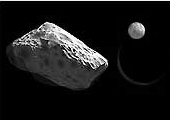
Potentially
Hazardous Asteroids (PHAs)
are space rocks larger than approximately
100m that can come closer to Earth than
0.05 AU. None of the known PHAs are on a
collision course with our planet, although
astronomers are finding new
ones all the time.
On
16 Jun 2004 there were 605
known Potentially
Hazardous Asteroids May-July
2004 Earth-asteroid encounters
| ASTEROID |
DATE
(UT) |
MISS
DISTANCE |
MAG. |
| 2001
US16 |
May
8 |
11
LD |
15 |
| 2004
HC39 |
May
12 |
13
LD |
17 |
| 2004
FJ11 |
May
24 |
12
LD |
18 |
| 1998
SF36 |
June
26 |
5
LD |
13 |
| 1999
MN |
July
14 |
7
LD |
16 |
Notes: LD is a
"Lunar Distance." 1 LD = 384,401
km, the distance
between Earth and the Moon. 1 LD also
equals 0.00256 AU. MAG is the
visual magnitude of the asteroid on the
date of closest approach.
link above is outside of the site kosmandu.org |
|
| Source-
spaceweather.com |
|
STATUS
REPORT
Date Released: Thursday, May 27, 2004
Source: Ames
Research Center
NEO
News: Spaceguard Progress
At
the end of 2003, there were 2600 known Near
Earth Asteroids (NEAs), and of these 691 are
brighter than absolute magnitude H=18, which is
taken to correspond to 1 km diameter. Of these,
131 are classed as PHAs (potentially hazardous
asteroids) larger than 1 km. These data from
Alan Chamberlin are posted on the JPL/NASA NEO
Program Office website.
For
comparison, there are estimated to be a total of
1100 +/- 100 NEAs larger than 1 km. Thus at the
end of 2003 scientists had found 63 percent of
these NEAs.
Recently
there appears to have been a modest slow-down in
the discovery rate of NEAs larger than 1 km,
perhaps reflecting the fact that we have already
discovered nearly 2/3 of this population group.
For the most recent three complete years (2001,
2002, and 2003), the numbers discovered are: 89,
95, and 67, respectively. We can check this
effect by noting that the total discovery rate
of all NEAs has not changed much, remaining at
about 450/yr. Previously, improvements in the
search systems more than compensated for the
declining number of unknown asteroids bigger
than 1 km waiting to be discovered.
The
Spaceguard Goal is 90 percent completeness by
the end of 2008. This corresponds to discovery
of 990 NEAs brighter than H=18 for the nominal
population. The survey passed its halfway mark
of 495 in mid-2000 (see NEO News, 08/01/00). The
75 percent objective is 742 NEAs larger than 1
km. If we anticipate 50 discoveries during 2004,
then the survey should reach this milestone at
the end of this year.
This
leaves 4 more years to increase the number of
known large NEAs from roughly 750 to 1000. To
meet this goal, the current (2003) discovery
rate of about 50/yr will need to be maintained
by improvements in the system to compensate for
a shrinking pool of undiscovered objects. Stay
tuned to see if this is accomplished.
The
2003 NASA study of sub-kilometer NEAS (NEO News,
07/23/03) focused on PHAs rather than NEAs. The
estimated population of PHAs larger than 1 km is
258 (from the NASA SDT Report, pg 21), leading
to a reformulated Spaceguard Goal of discovering
232 large PHAs by the end of 2008. The number of
131 PHAs (discovered as of the end of 2003) is
56 percent of the way to meeting the Spaceguard
goal. Please note that conversions between NEAs
and PHAs, as well as the total numbers above the
1 km size, vary because the assumptions about
such things as the conversion from magnitude to
diameter are not exactly the same in different
studies.
The
Spaceguard Survey is healthy and continuing
toward meeting its 90 percent goal sometime
between 2008 and 2010. However, the discovery
rate of large NEAs has apparently gone through
its peak. Larger aperture survey telescopes now
under design (at Lowell Observatory and the
University of Hawaii), of course, can be used in
the future to accelerate the discovery rate and
push into the sub-kilometer size range.
David
Morrison
NEO
Near Earth Objects News
These opinions are the responsibility
of the individual authors and do not represent
the positions of NASA, the International
Astronomical Union, or any other organization.
|